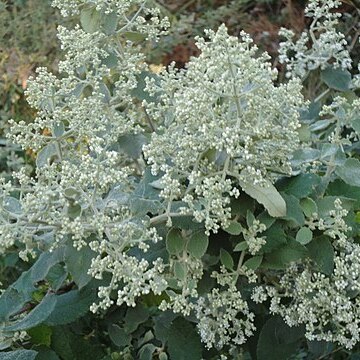Evergreen shrub, often semi-scrambling. Shoots angular, tomentose when young. Lvs opposite; petioles 1-2.5 cm long, tomentose. Lamina 4-10 × 2.5-6 cm, ovate, hairy above, densely greyish or pale brown stellate-tomentose below, coarsely and irregularly dentate; base broadly subcordate or cordate, forming a narrow petiolar wing; apex obtuse. Panicles broad-pyramidal, loose, composed of many small, densely tomentose cymes. Fls shortly pedicellate. Calyx densely tomentose; lobes broad-ovate, obtuse, ± imbricate, c. 1 mm long. Corolla c. 4 mm long, pale mauve or whitish; tube sparsely or moderately hairy outside, orange within; lobes = or slightly > tube, from ± oblong to suborbicular, reflexed. Stamens inserted near top of tube; filaments slender, 3-4 mm long; anthers small, well-exserted. Style c. 2 mm long; stigma ± capitate. Ovary tomentose. Fr. not seen.
Straggling or scandent shrub or climber, 0.9-7.0 m high, divaricately branched, ultimate branchlets terete to quadrate, striate, tawny or rusty pubescent to densely tomentose, with rather long, often stellate hairs. Leaves discolorous, dark green, glabrescent or stellate-tomentose above, stellate-pubescent beneath; blade deltoid-ovate to ovate, broadest at base, narrowing to deltoid subacute apex, margins irregularly dentate to crenate; petioles patent, tomentose, ridged or winged by decurrent leaf base. Inflorescences large, sublax, cymose panicles, with many small flowers; peduncles, pedicels and, calyces rusty or tawny substellate-tomentose to lanate, ultimate 3-flowered cymes not congested into heads. Flowers white or cream-coloured with maroon throat.
Climbing shrub, up to 3 m. tall, with rather shining brown bark; young parts densely yellow-brown floccose.. Leaves petiolate; petiole up to 1 cm. long, sometimes appearing longer when including wings from the lamina; lamina ovate or narrowly ovate, up to 11 cm. long, 5 cm. wide, narrowing above to an acute apex, truncate or rounded below to a cuneate base, especially in older leaves, dentate.. Inflorescence a lateral foliaceous doubly compound raceme of ± distant cymose clusters, up to 15 cm. long, and about 7 cm. in diameter; pedicels obscure.. Corolla white; lobes oblong, rounded above.. Stamens inserted at the mouth of the corolla-tube and ± longly exserted.. Ovary subspherical, densely floccose.. Capsule 2 mm. long, pubescent.. Fig. 7/1, p. 39.
Corolla white, greenish, creamy, or yellowish or sometimes pale mauve, with the throat maroon–coloured; lobes erect 2–3 times as long as the calyx and 2·5–5 mm. long, outside mostly at least on lobes papillose–pubescent and sometimes also pilose on tube on which both types of hairs may occur, inside papillose–pubescent on lobes, glabrous within tube; tube cup–shaped, often slightly contracted at the mouth, slightly longer than the calyx, about as long as the lobes, 1·2–2·4 x 1·2–2·2 mm., rounded, entire, suberect at first, later recurved.
Leaves opposite, petiolate; petiole hairy as branchlets, 0·3–3 cm. long; lamina almost triangular to ovate, 1–5–2(3) times as long as wide, 1–10 x 0·7–7·5 cm., with the base truncate, subcordate or wedge–shaped, often decurrent into the petiole, acuminate to rounded at the apex, irregularly dentate to crenate, sparsely to densely stellate–tomentose and glabrescent above, persistently sparsely to densely stellate–pubescent or –tomentose beneath; veins impressed above.
Straggling or scandent shrub, 1.5-7.0 m high. Leaves petioled, deltoid to ovate, simply toothed or crenate, flat. Stipules represented by conspicuous interpetiolar ridge. Corolla tube short, campanulate. Anthers and filaments exserted. Flowers white, dirty white, cream, white with maroon throat.
Pistil 2–4 mm. long; ovary obovoid or ellipsoid, laterally compressed, 1·2–2 x 0·9–1·3 x 0·5–1 mm., tomentose except for the glabrous disk–like base; style glabrous, broadened at the apex, with large 0·8–2 mm. long stigma; stigma up to half as long as the style, more or less peltate or clavate.
Sepals up to one third connate, sometimes two halfway united, equal or subequal, ovate or approximately so, 1–5–3 times as long as wide, 0·8–2 x 0·5–1 mm., obtuse to acuminate, entire, tawny– or rusty–tomentose outside, with a few minute glandular hairs or (less often) glabrous inside.
Stamens mostly well–exserted; filaments long, often curved, 1–3 mm. long, inserted 0·1–0·5 mm. below the corolla mouth; anthers subcircular in outline, 0–3–0–8 mm. long, glabrous, cordate at the base; cells slightly divergent at the base.
Seed pale brown, flattened, winged, often obscurely angular, circular, obliquely elliptic or ovate, often angular, 0·6–0·7 x 0·4–0·5 x 0·2 mm., pale brown, minutely reticulate.
Branchlets terete to quadrangular, striate, tawny or rusty–pubescent to densely tomentose (also in living specimen), hairs rather long and often stellate.
Inflorescence terminal, paniculate, large, lax or less often more or less congested in ultimate branchings, many–flowered, 4 x 4 to 20 x 20 cm.
Capsule ovoid or ellipsoid, 2·2–3·4 x 2·2·3 x 1·2–1·5 mm., tomentose, about 3 times as long as the calyx, apiculate.
Shrub, straggling or scandent (erect if growing isolated), 1–10 m. high, divaricately branched.
Flowers all at least shortly pedicellate, occasionally sessile, sweet–scented.
Bark pale brown.

